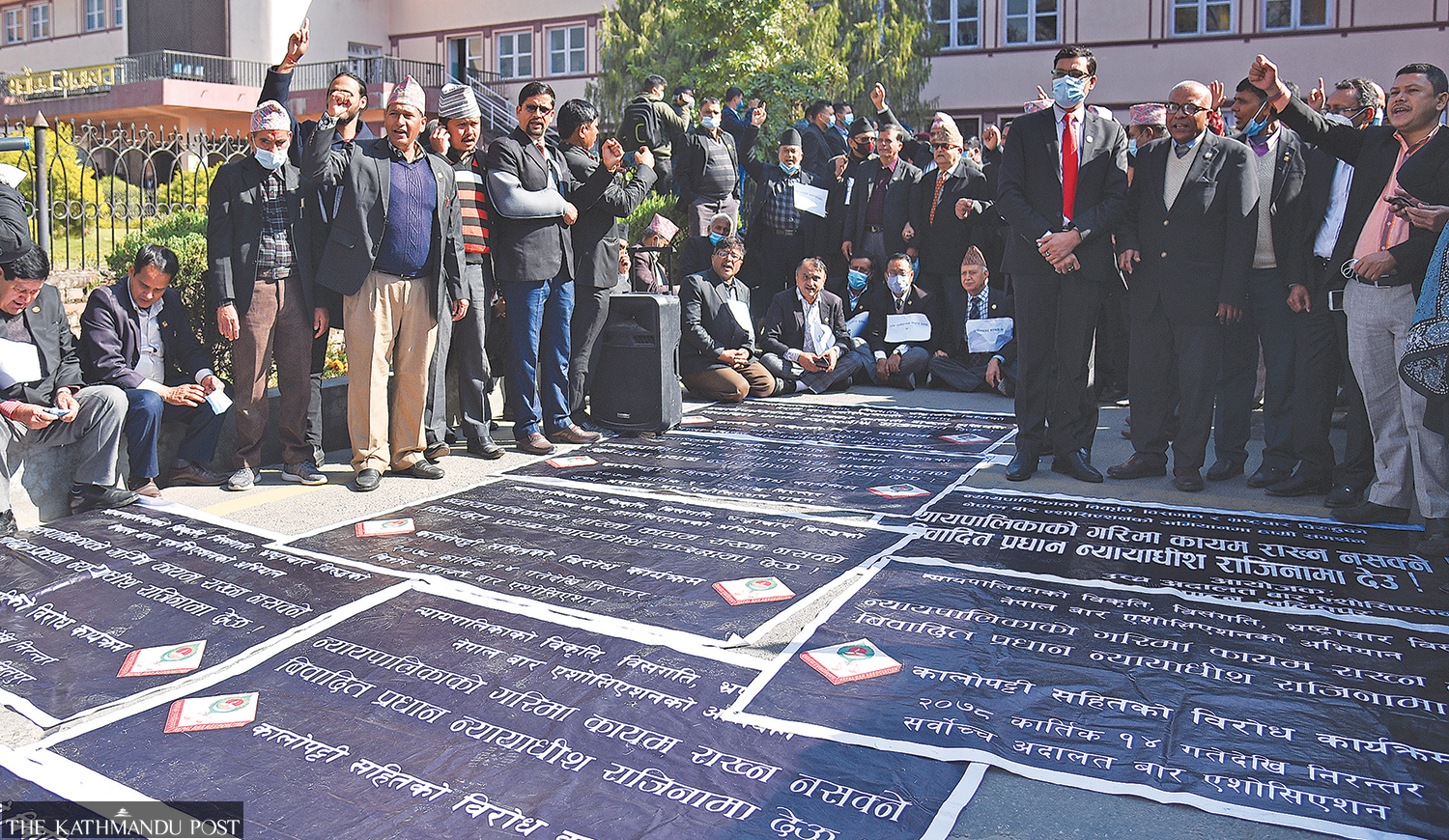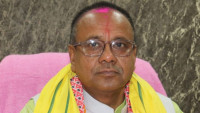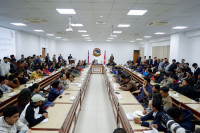National
Judiciary: Applause and then controversy and crisis
2021 has been the worst year in the history of the judiciary because it was embroiled in the ugliness of individual greed and the vested interests of its stakeholders.
Tika R Pradhan
On February 23, the five-member Constitutional Bench headed by Chief Justice Cholendra Shumsher Rana, the Supreme Court reinstated the Parliament dissolved earlier by the KP Sharma Oli government on December 20, 2020, earning widespread accolades.
Many including the parties rallying against the dissolution said that the judiciary brought the almost derailed political process and constitution back on track.
But as the year drew to a close, the judiciary was embroiled in a deep crisis of its own.
All 19 justices of the Supreme Court launched a campaign against Chief Justice Cholendra Shumsher Rana, leading to the disruption in justice delivery for five weeks.
The Nepal Bar Association and Supreme Court Bar Association joined the chorus for Rana’s resignation.

Probably for the first time in the history of Nepal’s judiciary, justice delivery was stalled for more than a month due to the agitation of both the justices and the lawyers.
On May 20, a single bench of Chief Justice Rana annulled the appointment of seven ministers who had deserted CPN (Maoist Centre).
At midnight of May 21, Prime Minister Oli dissolved the parliament for the second time following which 146 lawmakers from the opposition filed a writ petition demanding the House be reinstated and the President appoint Nepali Congress leader Sher Bahadur Deuba the new prime minister.
As many as 30 petitions were registered at the court on House dissolution.
After less than two months of the dissolution, the Supreme Court, on July 12, issued a mandamus order to appoint Deuba as the prime minister within 5 pm the following day.
Chief Justice Rana made a number of decisions that shocked the then Prime Minister Oli which included an order on June 10 to the government to not implement the Citizenship Amendment Ordinance.
After dissolving the parliament on May 22 Oli had expanded his cabinet on June 4 to accommodate the Thakur-Mahato faction of the Janata Samajbadi Party.
To rope in the party’s support, Oli had recommended the issuance of the Nepal Citizenship (First Amendment) Ordinance 2021 on May 23, days after he dissolved the House.
In another move that took Oli by surprise, on June 22, Chief Justice Rana through a division bench with Justice Prakash Kumar Dhungana quashed Oli’s appointment of 17 ministers citing that Oli’s moves to announce polls and to dissolve the House were unconstitutional.
The Supreme Court said Oli’s government has been reduced to a caretaker government after the unconstitutional moves.

Meanwhile, the justices had started boycotting Rana from October 25 asking him to pave the way for new leadership and reforms since he refused to make reforms in the judiciary. Rana had defamed the judiciary by dealing with the executive for the ministerial portfolio, said the justices.
While the justices returned to the benches on December 1 after the implementation of the lottery system which marked the end of the inherent right of the chief justice to assign cases, the lawyers are still continuing with their struggle demanding the chief justice’s resignation.
Deep division in the legal fraternity began to appear with camps forming overnight for and against Rana. A brawl broke out between two lawyers, footage of which was widely shared on social media platforms, who were for and against the demand for Rana’s resignation.
The year 2021 saw the judiciary becoming the centre of the country's politics with most of the political issues landing at the Supreme Court including issues from the federal and the provincial governments. During the second House dissolution, a majority of the 275-strong parliament were seen queuing outside the apex court to verify their signatures.
Legal experts have termed 2021 as the dark year in the history of the judiciary mainly due to the chief justice and the controversies that surround him.
“Actually during both the decisions on parliament dissolution four other justices in the five-member constitutional bench had overpowered the chief justice,” said Balaram KC, former justice of the Supreme Court. “He was not fit to become the justice of the Supreme Court but because he was elevated to the position, the judiciary had to suffer.”
According to KC, it was the chief justice who embroiled the judiciary in controversies for the first time in its history. “The judiciary had never been made to stoop so low,” KC told the Post. “Even during the autocratic Panchayat system, Nepal’s judiciary made several landmark verdicts against the government while upholding democratic values.”
Calls for reforms in the judiciary had been growing louder with even justices accused of bench shopping and corruption by different probe reports.
In its latest course of action, the Supreme Court Justice Hari Krishna Karki led a probe team comprised of Chairman of Nepal Bar Association Chandeswor Shrestha as its member had submitted the report on July 29 to the Chief Justice Cholendra Shumsher Rana.
The probe panel stated that the corruption began right from the selection of the bench wherein the justices were also involved. The probe panel, therefore, recommended an automated system of preparing the cause list which could stop such malpractices.
The probe panel also suggested that the judiciary begin a raffle system of preparing the cause list until the automated system is put in place.
Chief Justice Rana soon started to speak against the introduction of the raffle system even after his previous commitment to implement it; the justices started to put pressure on him. The situation escalated further after some media reports alleged Rana of dealing with the head of the executive to secure a ministerial position for one of his relatives.

On October 8, Gajendra Hamal, a district-level leader of the Nepali Congress, was appointed as Minister for Industry, Commerce and Supplies even though he was not a parliamentarian.
Hamal, a close relative of Rana, according to Nepali Congress insiders, was pitched by Rana amid much furore among the legal fraternity. Though Hamal resigned from his post two days after his appointment due to extreme pressure, the incident took an ugly turn with the entire legal fraternity focussing their attack on Rana accusing him of disgracing the judiciary once again by making a deal with the executive.
Former justices of the Supreme Court have claimed that 2021 has been the worst year in the history of the judiciary because it was embroiled in the ugliness of individual greed and the vested interests of its stakeholders.
“In 2021, the judiciary witnessed everything that should not have happened but nothing necessary for the judiciary,” said Prakash Osti, a former justice of the Supreme Court. “The judiciary was not embroiled in such a controversy ever in its history. Let’s hope this won’t repeat in the future.”
Observers say that whatever happened in the judiciary in 2021 could also be viewed as a chance to revamp the judiciary with the Nepal Bar Association claiming that Rana’s resignation would be the first step towards its reforms.
Osti said the events that defined the judiciary in 2021 should be an eye-opener for political parties and their leaders about the detrimental effects of their desire to influence the judiciary and its decisions. “This year has also taught a great lesson to the justices of the Supreme Court about the challenges in ensuring the independence of the judiciary. It has also underscored the importance of upholding the legacy of their predecessors,” Osti told the Post.




 20.12°C Kathmandu
20.12°C Kathmandu















